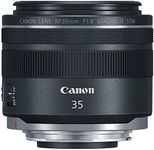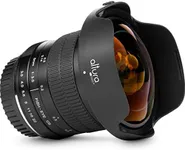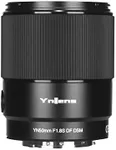Buying Guide for the Best Macro Lenses For Canons
Choosing the right macro lens for your Canon camera can significantly enhance your photography, especially if you are interested in capturing close-up details of small subjects like insects, flowers, or textures. Macro lenses are designed to provide high magnification and sharpness, allowing you to see fine details that are not visible to the naked eye. When selecting a macro lens, it's important to consider several key specifications to ensure you get the best fit for your needs and photography style.Focal LengthFocal length determines how close you can get to your subject and still achieve focus. Macro lenses typically range from 50mm to 200mm. Shorter focal lengths (50mm-100mm) are great for general close-up photography and are more affordable, but you need to get closer to your subject, which might disturb it. Longer focal lengths (100mm-200mm) allow you to shoot from a distance, which is ideal for photographing skittish subjects like insects. Choose a focal length based on the type of subjects you plan to photograph and how close you can get to them.
Maximum ApertureThe maximum aperture of a lens indicates how much light it can gather, which affects your ability to shoot in low light and control depth of field. A larger maximum aperture (e.g., f/2.8) allows more light in, making it easier to shoot in dim conditions and achieve a shallow depth of field, which can beautifully blur the background. If you often shoot in low light or want to create a strong background blur, look for a lens with a larger maximum aperture. For general macro photography in good light, a smaller maximum aperture (e.g., f/3.5 or f/4) may suffice.
Image StabilizationImage stabilization helps reduce camera shake, which is especially useful in macro photography where even slight movements can cause blur. Some macro lenses come with built-in image stabilization, which can be a significant advantage when shooting handheld or in low light. If you plan to shoot without a tripod or in conditions where stability is a concern, consider a lens with image stabilization. However, if you always use a tripod, this feature might be less critical.
Minimum Focusing DistanceThe minimum focusing distance is the closest distance at which a lens can focus on a subject. A shorter minimum focusing distance allows you to get closer to your subject, which can be beneficial for capturing extreme close-ups. This spec is particularly important in macro photography because it directly affects how much detail you can capture. If you want to photograph very small subjects or achieve high magnification, look for a lens with a short minimum focusing distance.
Magnification RatioThe magnification ratio indicates how much the subject is enlarged on the camera sensor. A 1:1 ratio means the subject is captured at life-size, which is ideal for true macro photography. Some lenses offer higher magnification ratios (e.g., 1.5:1 or 2:1), allowing for even greater detail. If you need to capture very fine details or want to enlarge small subjects significantly, choose a lens with a higher magnification ratio. For general close-up photography, a 1:1 ratio is usually sufficient.
Autofocus PerformanceAutofocus performance is crucial for quickly and accurately focusing on your subject, especially when dealing with moving subjects like insects. Some macro lenses have faster and more precise autofocus systems than others. If you often photograph moving subjects or need to capture shots quickly, look for a lens with good autofocus performance. For static subjects or if you prefer manual focus, this spec might be less important.
Build Quality and Weather SealingBuild quality and weather sealing are important for durability and protection against the elements. A well-built lens with weather sealing can withstand harsh conditions, making it suitable for outdoor photography. If you plan to shoot in various environments, including dusty or wet conditions, consider a lens with robust build quality and weather sealing. For indoor or controlled environments, this may be less of a concern.




















